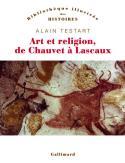Art et religion - de Chauvet à Lascaux
Alain Testart
Since the grottos were discovered, the question has been almost permanent, “why did prehistoric men cover the walls of grottos for over 20,000 years?” Will it ever have a decisive answer? Is it due to a simple artistic taste, magical hunting rites, shamanic rituals with the beyond? From Chauvet (circa -37 000) to Lascaux (circa -18 000), hundreds of grottos were decorated with paintings, but also with engravings. Anthropologist Alain Testart describes in a posthumous work –he passed away in 2013- and in a systematic way the signs left by our ancestors: animal species, sexual symbols or geometric motives. He suggests we see those grottos as spaces clearly defined as being feminine, sorts of large uteruses, that would prove a sort of Totemic thinking and a sophisticated cosmogony. The idea is rather complex, like for example when he looks at the questions of symmetry, that aim to prove that grottos such as Lascaux were places seen in their global aspect. This position is mitigated by the regular rhythm given by the chapters and the great number of illustrations.
|  |
Review published in the newsletter #453 - from 15 December 2016 to 21 December 2016
